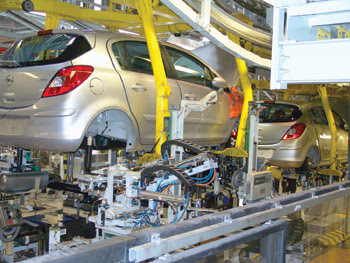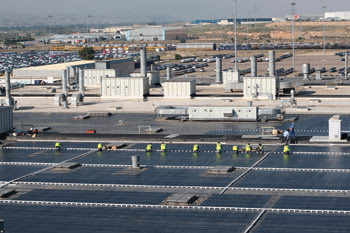Installing solar on a rooftop in Spain required overcoming technical and administrative challenges – all under the pressure to flip the switch in record time.
In Spain, companies are encouraged to host solar energy systems that produce electricity to be sold back to the utilities, where feed-in tariffs guarantee a set price for that energy. With that in mind, General Motors (GM), in a unique business partnership, is taking advantage of the nearly 3 million square feet of real estate on the roof of its car assembly plant in Figueruelas (near Zaragoza) by installing about 85,000 solar panels.

The GM plant in Figueruelas, Spain, produces cars on the inside and solar energy on its rooftop. Photo courtesy of General Motors.
GM is no novice to the rooftop solar energy business. It has two of the largest solar power installations in the US on the roofs of two of its parts warehouses, in Rancho Cucamonga and in Fontana, both in California. But the rooftop installation in Spain is the world’s largest to date.
This project, which sets a good example for industry as a leader in the use of renewable energy sources, is possible because of Spanish government incentives on all renewable energies. At full operation, the Figueruelas installation is expected to generate a maximum of 10 MW of peak power, which translates to 15.1 million kWh annually.
GM’s largest
The facility is the largest European GM plant in terms of volume, producing almost half a million vehicles in 2007 – including the Corsa, the Meriva and the Combo – and more than 9 million cars in its 26 years there. To facilitate solar energy installation and distribution, GM is dedicating its roof space to a joint venture company – Veolia Environnement SA of Paris, Clairvoyant Energy of Santa Barbara, Calif., and the government of Aragon, Spain – that is partnering in the construction and operation of the 10-MW solar power station. The annual output is expected to provide enough power for 4600 households, with an average annual consumption of 3300 kWh.
The solar array consists of lightweight solar modules with an active photovoltaic surface area of 183,000 square meters. Thin-film flexible laminate from United Solar Ovonic LLC of Auburn Hills, Mich., was chosen by Clairvoyant Energy of Zaragoza for the project. The laminate uses triple-junction thin-film silicon solar cells attached with Velcro and installed on a flat surface rather than as glass modules racked and mounted to the roof. The benefits are low weight (less than 1 pound per square foot), conformation to the roof surface, easy installation and the high-energy output of triple-junction amorphous silicon.
Veolia Environnement and Clairvoyant Energy, the project integrators, found that it took a great amount of time and experience wading through the government approval process. According to Christine Hanon, a director of Veolia Environnement, the tariff process has many steps, so having the experience of complying with legal details helped keep the project on task.
The greatest challenge was coordinating all aspects of the project to meet the government-mandated deadline. The installation had to be completed and government approval had to be in place by Sept. 27, 2008. The process was a little like juggling 10 balls at once because, not only did the team have to design the project – 85,000 panels, 20 inverters and a 20-MW transformer – but it had to manage the suppliers’ delivery schedules.

Workers install cabling to connect the thin-film panels in GM’s massive rooftop solar installation. Photo courtesy of Veolia Environnement.
The transformer, which was built by Schneider Electric SA of Rueil-Malmaison, France, was a major challenge in terms of deadlines. “Normally, equipment of this size takes 12 to 18 months to manufacture, but they did this one in eight months,” Hanon acknowledged. Then there were the inverters, panels, adapters, cabling and so on. Supplies came from around the globe, and because the project leaders used European and American equipment with no compatible adapter standards, Hanon indicated that “making sure everything interfaced was another challenge.”
A no-brainer
The concept of generating power with solar panels on rooftops the size of several football fields seems like a no-brainer. After all, it doesn’t require taking up additional land or installing unsightly collectors across the countryside. But it’s really not that simple. The project designers understand that knowledge of building construction also is important in ensuring that there is no interruption of the core business of facility owners.
It also comes down to the prices that countries have set for the energy purchased through the feed-in tariffs, which determine whether the project will have high enough returns to make it cost-effective. But governments are putting those tariffs into place to help launch the industry, and once it takes off, they will reduce the incentives and lower the prices they are guaranteeing for the energy.
According to Hanon, in the end it is all about working with suppliers to keep prices down. She sees the next five years as crucial in determining the direction of the industry.
John Abkemeier, president of Clairvoyant Energy, said, “Projects like this allow for the continued funding of R&D, where new technologies will result in lower-cost solutions.”
GM Europe President Carl-Peter Forster said that the company’s commitment to environmental compatibility is in evidence on a rooftop in Spain today but that tomorrow it may be seen in extended-range-electric or alternative-energy-fueled vehicles.